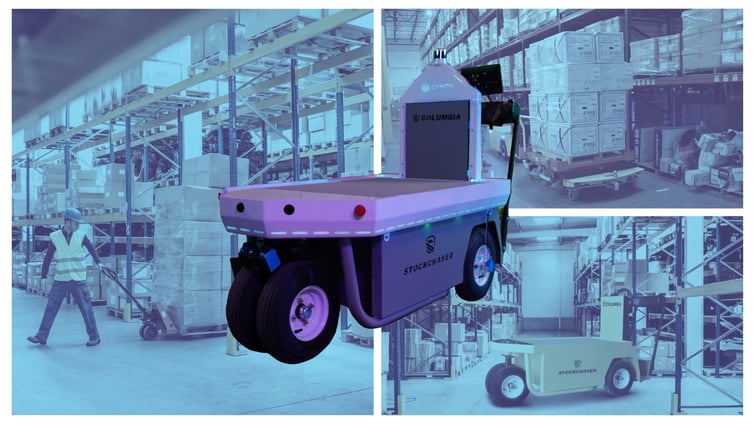- Autonomous vehicles help minimize the adverse impact of productivity challenges that stem from human resources problems, allowing companies to experience operational efficiency gains of upwards of 50%.
- Of the 1,000 supply chain and manufacturing leaders, 50% state that labor shortages are their largest challenge. AMRs can address this problem by helping companies streamline inefficient tasks and retain workers.
- Autonomous technology gives manufacturing organizations increased flexibility and scalability that helps them combat high demand.
In light of Industry 4.0, automation will play a large part in shaping the future of the manufacturing industry. Manufacturing companies are addressing some of the largest challenges that are currently impacting the industry with autonomous technology. By 2027, the industrial automation industry is expected to reach $306.2B.
Implementing autonomous vehicle technology allows companies to remain competitive and improve the efficiency of their facilities.
Let’s explore how autonomous vehicles can create new opportunities for growth and help address low productivity, labor shortages, and increased demand.
(1) Increase Productivity
In manufacturing, companies face inefficiency in their operations due to low productivity, which in turn affects overall business and profits. Productivity is impacted by the extent of human capabilities, as workers come with human constraints.
Lack of productivity can stem from repetitive tasks, working during undesirable hours, and operating in uncomfortable conditions or unsafe working environments. In fact, S&P companies reported $150 million in losses in one year, simply due to human error.
Autonomous vehicles provide the opportunity to minimize the adverse impact of productivity challenges associated with a company’s core operations. AMRs can simplify workflows without changing the infrastructure, quickly, and without the level of extensive training that humans require. It is estimated that the benefits of industrial vehicle automation can produce operational efficiency gains of upwards of 50%.
Autonomous vehicles can further be relied on to fill the voids that tend to create the human resource problems listed above, which contribute to inefficiencies. AMRs will increase the work capacity of an existing workforce as businesses can optimize labor by having workers shift their efforts into other more productive tasks. They will be able to complete time-consuming, repetitive tasks efficiently without facing safety concerns, boredom, or restricted working hours.
 A Deloitte case study specifically looked at a parts manufacturing and fulfillment facility that utilized AMRs to pick products from the back of their large distribution center. By introducing autonomous vehicle technology, the facility was able to save employees time, provide respite from unstimulating tasks, and improve overall morale and productivity.
A Deloitte case study specifically looked at a parts manufacturing and fulfillment facility that utilized AMRs to pick products from the back of their large distribution center. By introducing autonomous vehicle technology, the facility was able to save employees time, provide respite from unstimulating tasks, and improve overall morale and productivity.
Additionally, customer-facing fleet tools can help increase productivity. At Cyngn, Cyngn Insight, our intelligent control center, helps businesses aggregate data to extract business insights. Using Cyngn Insight, facilities can watch out for predictive maintenance, operation improvement, educating employees, and more. Results from both Deloitte and McKinsey use cases for performance management analytics driven by automation found that productivity increased by 20-70%.
(2) Address Labor Shortages
By increasing productivity, companies can also address one of the largest industry challenges that exist today, labor shortages. The hiring, training, and retention of qualified workers is becoming increasingly difficult for the markets that material transport vehicles operate within. According to Deloitte’s 2020 and 2021 Material Handling Industry Report, 50% of the 1,000 supply chain and manufacturing leaders surveyed rated hiring and employee retention as their biggest challenges.
It is not only difficult to find skilled labor but also costly. The average cost of manufacturing labor in the U.S. has increased by 20% since 2010 according to McKinsey & Company. A lack of qualified workers results in other types of risks for organizations including a lack of safety, productivity, and impact on budget. By 2030, the impact of unfilled open jobs in the manufacturing industry could cost the US economy more than $1 trillion.
Companies can turn to autonomous vehicle technology to address labor shortages and improve their workplaces and processes. “Autonomy allows companies to solve problems that they have never been able to solve before”, says Greg Breckley, Directory of Business Development at Columbia Vehicle Group. With AMRs, workers can focus on the value-adding, high-dollar jobs instead of the day-to-day, repetitive ones, helping streamline inefficient tasks.
Every phase of pick and pack, for instance, requires an employee, both picking on the shelves, transporting horizontal material handling, and unloading at the other end. With autonomy, organizations don’t need to find a worker to fill the middle role. Employees can focus on picking and packing parts, where they make a 3PL the most money. This further helps eliminate costs related to the training of employees.
Automation also helps companies retain qualified workers. By automating these mundane tasks, organizations will foster a safer environment and create more satisfying work opportunities for employees. Specifically, existing employees will be exposed to new technology and develop valuable career development opportunities.
For example, a manufacturing community in Wisconsin successfully retrained their employees to be skilled in AMR maintenance after AMRs replaced their traditional conveyors. The introduction of these new career opportunities created a more rewarding work environment, which in turn improves the currently low retention rates.
(3) Scalability
In addition to labor shortages, manufacturing companies are facing increased demand. According to the 2021 State of Manufacturing report, a vast majority of manufacturers are seeing a surge in demand that is between 25% to 50%. This increase in demand is met with a lack of ability for organizations to add capacity.
With increased demand, it is difficult for organizations to scale the expansion of their operations, especially when paired with the already challenging ability to find labor. In fact, 60% of manufacturers have been able to increase capacity by an average of only 8%, a very small amount.
The pandemic has largely affected this demand. However, despite the fact that the spread of COVID-19 has started to slow down, these demand fluctuations are the future reality for manufacturers. The report further estimates that more than 54% of companies see this demand surge being a long-term problem.
Autonomous vehicles help provide a powerful solution to scalability challenges. Autonomy allows companies to have a flexible infrastructure and in turn, efficiently scale their operations when needed. AMRs are able to respond quickly and more efficiently to changes in demand, increasing supply chain speeds at an organization’s facility.
If a manufacturer needs to open a new facility, then AMRs can further provide the necessary flexibility. Operations can continue to run when these changes occur, resulting in little downtime as a result of delays in operations or having to hire and train workers. This technology will further help organizations “future-proof” themselves for potential disruptions to the supply chain in the future.
Another way to increase scalability is by reducing strains related to service lifecycle management and deployability. At Cyngn, this scalability is strengthened by our ability to deploy AV technology on diverse vehicle fleets. Further, Cyngn’s Enterprise Autonomy Suite (EAS) includes common interfaces and experiences that unify one’s AV operations. This in turn, reduces the costs associated with expanding AV operations across sites.
References:
